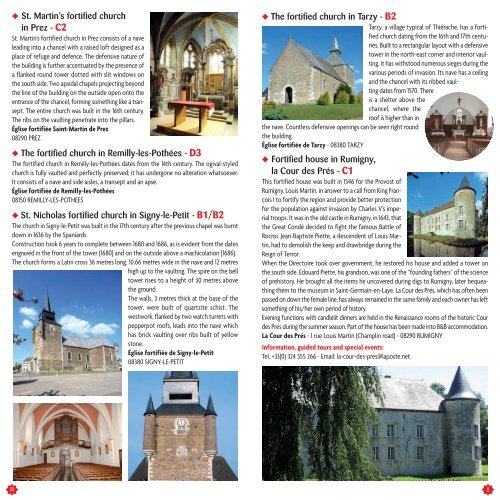La Thiérache – Rocroi Plateau – Sormonne Valley - Office de ...
La Thiérache – Rocroi Plateau – Sormonne Valley - Office de ...
La Thiérache – Rocroi Plateau – Sormonne Valley - Office de ...
You also want an ePaper? Increase the reach of your titles
YUMPU automatically turns print PDFs into web optimized ePapers that Google loves.
◆ St. Martin’s fortified church<br />
in Prez - C2<br />
St. Martin’s fortified church in Prez consists of a nave<br />
leading into a chancel with a raised loft <strong>de</strong>signed as a<br />
place of refuge and <strong>de</strong>fence. The <strong>de</strong>fensive nature of<br />
the building is further accentuated by the presence of<br />
a flanked round tower dotted with slit windows on<br />
the south si<strong>de</strong>. Two apsidal chapels projecting beyond<br />
the line of the building on the outsi<strong>de</strong> open onto the<br />
entrance of the chancel, forming something like a transept.<br />
The entire church was built in the 16th century.<br />
The ribs on the vaulting penetrate into the pillars.<br />
Église fortifiée Saint-Martin <strong>de</strong> Prez<br />
08290 PREZ<br />
◆ The fortified church in Remilly-les-Pothées - D3<br />
The fortified church in Remilly-les-Pothées dates from the 14th century. The ogival-styled<br />
church is fully vaulted and perfectly preserved; it has un<strong>de</strong>rgone no alteration whatsoever.<br />
It consists of a nave and si<strong>de</strong> aisles, a transept and an apse.<br />
Église fortifiée <strong>de</strong> Remilly-les-Pothées<br />
08150 REMILLY-LES-POTHEES<br />
◆ St. Nicholas fortified church in Signy-le-Petit - B1/B2<br />
The church in Signy-le-Petit was built in the 17th century after the previous chapel was burnt<br />
down in 1636 by the Spaniards.<br />
Construction took 6 years to complete between 1680 and 1686, as is evi<strong>de</strong>nt from the dates<br />
engraved in the front of the tower (1680) and on the outsi<strong>de</strong> above a machicolation (1686).<br />
The church forms a <strong>La</strong>tin cross 36 metres long, 10.66 metres wi<strong>de</strong> in the nave and 12 metres<br />
high up to the vaulting. The spire on the bell<br />
tower rises to a height of 30 metres above<br />
the ground.<br />
The walls, 3 metres thick at the base of the<br />
tower, were built of quartzite schist. The<br />
westwork, flanked by two watch turrets with<br />
pepperpot roofs, leads into the nave which<br />
has brick vaulting over ribs built of yellow<br />
stone.<br />
Église fortifiée <strong>de</strong> Signy-le-Petit<br />
08380 SIGNY-LE-PETIT<br />
10<br />
◆ The fortified church in Tarzy - B2<br />
Tarzy, a village typical of <strong>Thiérache</strong>, has a fortified<br />
church dating from the 16th and 17th centuries.<br />
Built to a rectangular layout with a <strong>de</strong>fensive<br />
tower in the north-east corner and interior vaulting,<br />
it has withstood numerous sieges during the<br />
various periods of invasion. Its nave has a ceiling<br />
and the chancel with its ribbed vaulting<br />
dates from 1570. There<br />
is a shelter above the<br />
chancel, where the<br />
roof is higher than in<br />
the nave. Countless <strong>de</strong>fensive openings can be seen right round<br />
the building.<br />
Église fortifiée <strong>de</strong> Tarzy - 08380 TARZY<br />
◆ Fortified house in Rumigny,<br />
la Cour <strong>de</strong>s Prés - C1<br />
This fortified house was built in 1546 for the Provost of<br />
Rumigny, Louis Martin, in answer to a call from King François<br />
I to fortify the region and provi<strong>de</strong> better protection<br />
for the population against invasion by Charles V’s imperial<br />
troops. It was in the old castle in Rumigny, in 1643, that<br />
the Great Condé <strong>de</strong>ci<strong>de</strong>d to fight the famous Battle of<br />
<strong>Rocroi</strong>. Jean-Baptiste Piette, a <strong>de</strong>scen<strong>de</strong>nt of Louis Martin,<br />
had to <strong>de</strong>molish the keep and drawbridge during the<br />
Reign of Terror.<br />
When the Directoire took over government, he restored his house and ad<strong>de</strong>d a tower on<br />
the south si<strong>de</strong>. Edouard Piette, his grandson, was one of the “founding fathers” of the science<br />
of prehistory. He brought all the items he uncovered during digs to Rumigny, later bequeathing<br />
them to the museum in Saint-Germain-en-<strong>La</strong>ye. <strong>La</strong> Cour <strong>de</strong>s Prés, which has often been<br />
passed on down the female line, has always remained in the same family and each owner has left<br />
something of his/her own period of history.<br />
Evening functions with candlelit dinners are held in the Renaissance rooms of the historic Cour<br />
<strong>de</strong>s Prés during the summer season. Part of the house has been ma<strong>de</strong> into B&B accommodation.<br />
<strong>La</strong> Cour <strong>de</strong>s Prés - 1 rue Louis Martin (Champlin road) - 08290 RUMIGNY<br />
Information, gui<strong>de</strong>d tours and special events:<br />
Tel. +33(0) 324 355 266 - Email: la-cour-<strong>de</strong>s-pres@laposte.net<br />
11


